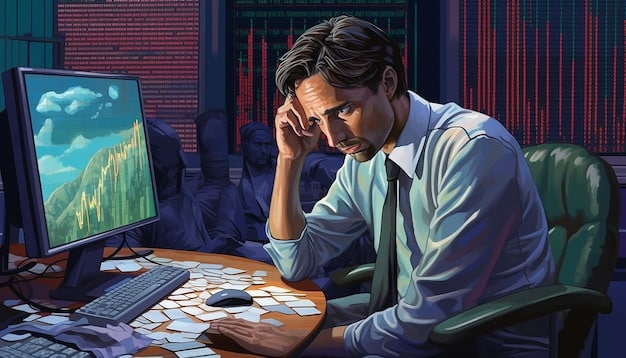New 15% Royalty Rate: Impact on US Musicians’ Earnings in 2025

The new 15% royalty rate for streaming services in 2025 is projected to significantly impact US musicians by potentially increasing their earnings from digital streams, particularly for independent artists and those with moderate play counts, while reshaping negotiations between labels, distributors, and platforms.
The landscape of music consumption has dramatically shifted towards streaming, redefining how artists earn revenue. As 2025 approaches, a pivotal change is set to alter this dynamic for many: a new 15% royalty rate for streaming services. This adjustment could profoundly influence the financial stability and creative output of United States musicians, sparking both optimism and apprehension about its long-term effects on the industry.
understanding the music streaming royalty ecosystem
To fully grasp the implications of a 15% royalty rate, it’s essential to first understand the complex ecosystem of music streaming royalties. This involves various stakeholders, each taking a cut from the revenue generated by plays. Historically, artists have often found themselves at the bottom of this financial food chain, with their share feeling disproportionately small compared to the overall revenue generated by platforms and labels. The current system is a multi-layered structure where money flows from subscribers to platforms, then to rights holders, and finally, a fraction reaches the artists.
The process begins when a subscriber pays their monthly fee or streams an ad-supported track. This revenue is then distributed based on complex agreements. Major record labels and publishers often have preferential deals, leaving independent artists and smaller labels to navigate a less favorable landscape. This disparity has been a long-standing point of contention, leading to calls for reform and greater transparency in how these funds are allocated.
key players in royalty distribution
- 🎧 Streaming Platforms: Services like Spotify, Apple Music, and Amazon Music collect subscription fees and ad revenue. They then distribute a significant portion (often around 70%) to rights holders.
- 💽 Record Labels: For signed artists, labels typically receive the bulk of the recording royalties, which they then share with artists based on their individual contracts.
- 🎵 Publishers and Collecting Societies: These entities manage the publishing rights (for the composition itself) and collect performance royalties, which are then distributed to songwriters and composers.
- 🎤 Distributors: Independent artists often use distributors (e.g., DistroKid, TuneCore) to get their music onto streaming platforms, taking a fee or a small percentage of royalties.
The percentage that ultimately reaches musicians can vary wildly, depending on their contracts, their status (signed vs. independent), and the type of rights involved (e.g., recording vs. publishing). Many artists report receiving fractions of a cent per stream, a figure that becomes especially problematic for emerging artists who require millions of streams to earn a living wage from their music alone. This intricate web of agreements and percentages highlights why any change to a core royalty rate can send ripples through the entire industry.
Against this backdrop, the prospect of a standardized 15% royalty rate emerges as a potential game-changer. It suggests a more substantial, if not entirely equitable, distribution of streaming revenue directly to artists, bypassing some of the historical bottlenecks and complexities that have limited their earning potential. However, the exact mechanics of its implementation and who benefits most remain central to the discussion.
the specifics of the new 15% royalty rate explained
The impending 15% royalty rate for streaming services in 2025 is not a sudden, arbitrary figure but rather the culmination of years of advocacy, legal battles, and regulatory adjustments aimed at rebalancing the financial scales within the music industry. Understanding its precise nature and origin is critical to evaluating its potential impact on US musicians. This rate primarily refers to the mechanical royalty rate songwriters and publishers receive for the reproduction and distribution of musical compositions.
Historically, these rates have been subject to review by the Copyright Royalty Board (CRB), a three-judge panel that sets statutory rates for various music uses in the United States. Following a lengthy process, which included appeals and negotiations, the CRB affirmed an increase in mechanical royalty rates for compositions used on streaming services. This rate rise is designed to ensure a more equitable share for the creators of the music itself, rather than solely focusing on the sound recording portion, which often goes to labels and performing artists under separate agreements.
breakdown of the CRB decision
- 📈 Rate Increase: The CRB’s decision phases in an increase in the mechanical royalty rate over several years, culminating in the 15% figure by 2025. This means that streaming services will pay a larger percentage of their revenue (or a minimum per subscriber, whichever is higher) to publishers and songwriters.
- ⚖️ Legal Battles: The increase wasn’t without contention. Streaming services initially appealed the decision, arguing that it was too high and unsustainable. However, the CRB’s findings largely stood, affirming the need for greater compensation for creators.
- 🎯 Targeted Beneficiaries: While often generalized as impacting “musicians,” this particular rate primarily benefits songwriters and their publishers. Performing artists (singers, instrumentalists) who are also songwriters will benefit directly from this increase, often through their publishing agreements.
It’s important to differentiate this mechanical royalty from the separate performance royalties (collected by performance rights organizations like ASCAP and BMI) and sound recording royalties (paid to record labels and performing artists). While all are crucial components of an artist’s income, the 15% figure specifically addresses the mechanical right. This distinction is vital because a songwriter, even if they don’t perform their own works, will see a direct benefit. Conversely, a performing artist who does not write their own music will not see a direct increase from this specific royalty rate change regarding their sound recordings.
The move towards a 15% mechanical royalty rate represents a significant victory for songwriter advocacy groups who have long argued that the previous rates were insufficient given the massive growth and profitability of streaming. This adjustment is an attempt to ensure that, as streaming continues to dominate music consumption, the creators of the underlying musical works receive fair compensation, setting a new precedent for future royalty negotiations and potentially influencing other areas of music rights management.
potential financial implications for US musicians
The financial ramifications of the 15% royalty rate for streaming services, effective in 2025, are complex and will manifest differently across various segments of the US music community. While the increase is generally viewed as a positive step for creators, its impact hinges on an artist’s role in the creative process and their existing contractual agreements. For songwriters, especially those who primarily earn income from their compositions, this change could represent a substantial uplift in earnings.
Consider an independent songwriter whose catalog generates a moderate number of streams. An increase from previous rates to 15% means a larger slice of the revenue pie allocated to the mechanical royalty pool. This direct increase in the per-stream payout for publishing rights could shift their financial viability significantly. For many, it might mean the difference between pursuing music as a hobby and making it a sustainable career. The aggregate impact across millions of songs and billions of streams could inject considerable new capital into the songwriting community.
who benefits most and least?
- ⬆️ Songwriters (including artist-songwriters): These are the primary beneficiaries. Artists who write their own music stand to gain from both their performance and publishing royalties, seeing a more balanced income stream.
- ↔️ Established Songwriters and Publishers: Those with extensive catalogs and consistent placements will see a proportional increase in their already substantial mechanical royalty income.
- ⬇️ Performing Artists (non-songwriters): Athletes who solely perform music written by others, and whose income is mainly from sound recording royalties or performance fees, might not see a direct financial uplift from this specific change. Their gains would depend on separate negotiations concerning sound recording rates.
However, it’s also important to consider the potential downstream effects. While streaming services are now obligated to pay a higher rate for mechanicals, this doesn’t automatically mean a uniform increase in overall artist income. The money allocated to mechanical royalties is part of a larger revenue share distributed by platforms. Any significant reallocation could lead to discussions about adjustments in other royalty streams, such as those for sound recordings. Record labels, for example, may face pressure to renegotiate their deals with artists or streaming platforms in light of these changes.
Analysing individual income statements will be key. Artists will need greater transparency from their distributors, labels, and performance rights organizations to verify that the increased mechanical rates are being accurately reflected in their payouts. This shift may also empower independent artists to demand more favorable terms from their digital distributors, particularly those offering “all-in” deals that might previously have obscured the true value of their publishing rights. The 15% rate is a landmark change, but its ultimate financial benefit will require careful tracking and understanding by every musician.
challenges and potential drawbacks for musicians
While the 15% royalty rate increase is largely hailed as a positive development, it’s crucial to examine the challenges and potential drawbacks it might present for US musicians. A higher royalty rate for songwriters could shift the financial dynamics within the music industry in unforeseen ways, potentially creating new pressures or exacerbating existing inequalities for certain artists. The music economy is a zero-sum game in many respects, and reallocating revenue to one group might mean less for another, or at least a ripple effect of adjustments.
One primary concern revolves around the potential for streaming services to seek to offset these increased costs. Platforms operate on business models reliant on profitability, and a higher payout to songwriters could compel them to look for cost-saving measures elsewhere. This might manifest in stricter licensing terms for sound recordings, or perhaps even a slowdown in payouts for other royalty categories. Artists, particularly those without strong negotiating power, could inadvertently find themselves caught in the middle of these commercial adjustments.

potential hurdles and unintended consequences
- 💼 Negotiation Leanings: Record labels might become less willing to offer generous advances or higher artist royalty splits if they perceive their own revenue share from streaming to be under pressure. This could particularly affect emerging artists seeking their first major deals.
- 📈 Increased Competition for Placements: With higher earnings potential for songwriters, competition for songwriting placements and co-writes might intensify. This could benefit established, successful songwriters but potentially make it harder for new talent to break through.
- 🔍 Transparency Issues: While the rate increase is clear, the actual distribution of funds often remains opaque. Musicians will still need robust mechanisms and auditing capabilities to ensure they are receiving their rightful share, especially from complex global revenue streams.
- 🔄 Focus on Sound Recordings: There’s a risk that the industry’s focus might shift even further towards proprietary sound recordings (owned by labels) to maximize their income, potentially narrowing opportunities for independent songwriters or producers.
Another challenge lies in the complex contractual relationships between artists, labels, publishers, and distributors. Many existing agreements contain provisions that dictate how mechanical royalties are split or how advances are recouped. Even with a higher statutory rate, an artist’s individual contract might limit their immediate benefit. Renegotiating these contracts can be a lengthy, costly, and often difficult process, especially for artists who lack robust legal representation. Furthermore, the administrative burden of tracking and distributing these increased royalties could become more complex, especially for independent collecting societies or smaller publishers who might struggle with scaling their operations to handle the larger volume of transactions and distributions. This adjustment, while positive in principle, necessitates a careful and strategic approach from artists and their advocates to fully capitalize on its benefits while mitigating potential pitfalls.
industry reactions and expert opinions
The announcement and affirmation of the 15% royalty rate have elicited a spectrum of reactions across the music industry, with various stakeholders offering their perspectives on its implications. Unsurprisingly, sentiment often aligns with each group’s position in the revenue chain, revealing both cautious optimism and lingering concerns about the industry’s long-term sustainability and fairness. Artists and songwriter advocacy groups have largely celebrated the increase as a crucial step towards fair compensation.
Many artists, particularly those who pen their own tunes, see this as an acknowledgment of their invaluable contribution to the music ecosystem. Organizations like the National Music Publishers’ Association (NMPA) and the Songwriters of North America (SONA) have been at the forefront of lobbying for such changes, arguing that the previous mechanical royalty rates were simply inadequate in the streaming era. They view the 15% rate as a monumental victory, providing a more robust foundation for songwriters to earn a living wage and continue creating. However, their enthusiasm is often tempered with the understanding that the fight for equitable artist compensation is far from over.
diverse viewpoints from industry leaders
- 🎤 Artist Advocates: Largely supportive, viewing it as a necessary correction to historical imbalances. They emphasize that while not perfect, it’s a significant positive shift for songwriters’ financial health.
- 🏢 Labels and Publishers: Publishers are direct beneficiaries and are largely positive, anticipating increased revenue. Record labels have a more nuanced view; while they recognize the need for fair compensation, they also watch how this impacts the overall revenue pie and their own artist agreements.
- 🎧 Streaming Services: Have historically opposed such increases, citing concerns about their business models and potential impact on subscriber growth. Their public statements often balance acceptance of the CRB’s decision with reassurances about continued investment in the music ecosystem.
Legal and financial experts who specialize in intellectual property and the music business have also weighed in, offering analytical perspectives. Many point out that while the 15% rate is a substantial improvement for mechanical royalties, it doesn’t resolve all issues of artist compensation. They highlight that the bulk of streaming revenue still flows to sound recording rights holders (often labels), and that per-stream rates for performing artists remain critically low. Therefore, while a significant milestone, it’s considered one piece of a much larger puzzle in reforming music remuneration.
The consensus among many experts is that this change will undoubtedly empower songwriters, particularly independent ones, but it also necessitates continued vigilance. They suggest that the music industry, moving forward, will need to adapt to these new financials, potentially altering how deals are structured and how artists receive their due. The 15% rate sets a new benchmark, fostering discussions around what truly constitutes fair compensation for all creators in a digital-dominated landscape.
strategies for US musicians to maximize new royalty earnings
With the 15% royalty rate for streaming services on the horizon for 2025, US musicians, particularly those who write their own material, have an opportunity to strategically position themselves to maximize these new earnings. This isn’t a passive income increase; it requires proactive engagement with their intellectual property, contracts, and revenue streams. Understanding where and how this new rate impacts their specific situation is the first step towards capitalizing on it.
For independent artist-songwriters, a key strategy involves careful management of their publishing rights. Many may have ceded partial control or neglected to properly register their compositions. Engaging with a reputable music publisher or a digital distribution service that offers robust publishing administration can ensure that every stream generating a mechanical royalty is accurately tracked and paid. This includes ensuring correct metadata is attached to all tracks, as incorrect or incomplete data is a leading cause of unpaid royalties in the digital age.
actionable steps for artists
- ✍️ Understand Your Contracts: Review existing agreements with labels, publishers, and distributors. Clarify how mechanical royalties are handled and if the increased rates will flow directly to you or how they might affect recoupment.
- 📝 Register Your Works: Ensure all original compositions are properly registered with your Performing Rights Organization (PRO – e.g., ASCAP, BMI) and with the Mechanical Licensing Collective (MLC), which is responsible for collecting and distributing mechanical royalties from streaming services in the US.
- 🤝 Seek Professional Advice: Consult with entertainment lawyers or financial advisors specializing in music. They can help navigate complex contractual language, negotiate better terms, and optimize your overall royalty collection strategy.
- 📊 Demand Transparency: Actively request detailed royalty statements from all relevant parties (distributors, labels, publishers, PROs). Learn to interpret these statements to verify accurate payments and identify any discrepancies.
- 🚀 Focus on Quality and Volume (Strategically): While quality always matters, a higher mechanical royalty rate means that songwriters with a larger catalog of frequently streamed songs will see a more significant boost. Consider co-writing opportunities to expand your reach and catalog.
Another avenue for optimization involves exploring opportunities for direct licensing or alternative distribution models that offer greater transparency and a larger share of publishing revenues. Some platforms and services are emerging that allow artists more direct control over their rights, potentially cutting out intermediaries that take a percentage. While this requires more administrative effort, the increased mechanical royalty rate makes such direct relationships potentially more lucrative.
Ultimately, maximizing the benefits of the 15% royalty rate demands a holistic approach to an artist’s business. It’s about being informed, proactive, and assertive in claiming what is rightfully due. By understanding the intricacies of music law and industry practices, US musicians can turn this regulatory change into a substantial financial advantage, fostering greater creative independence and sustainability.
the long-term impact on the US music industry landscape
The introduction of a 15% royalty rate for streaming services in 2025 is more than just a financial adjustment; it represents a significant shift that could fundamentally reshape the US music industry landscape over the long term. This recalibration of value distribution within the streaming economy has the potential to influence everything from artist development and contractual agreements to the very nature of music creation and consumption. Its implications extend far beyond individual artist checks, touching on market dynamics, investment patterns, and the balance of power among industry players.
One profound long-term impact could be a re-evaluation of the songwriter’s role and value. For decades, the performing artist often captured the lion’s share of public attention and financial reward, while songwriters, though critical, remained somewhat in the background. A more equitable mechanical royalty rate could elevate the perceived professional stature and financial independence of songwriters, potentially attracting more talent to the craft and fostering a more vibrant songwriting community. This might lead to a greater emphasis on song composition as a standalone career, independent of performing.
anticipated shifts and future trends
- 🔄 Rebalancing Power: While streaming services and major labels have historically held significant leverage, increased songwriter compensation could empower creators, leading to more artist-friendly deal terms and a greater emphasis on intellectual property rights.
- 💰 Investment in Publishing: Expect to see increased investment in music publishing catalogs and rights. Companies may become more aggressive in acquiring or signing songwriters, recognizing the enhanced value of mechanical royalties.
- 💡 Innovation in Royalty Tracking: The push for fair compensation will likely accelerate the development of more transparent and efficient blockchain-based or AI-driven royalty tracking and distribution systems, benefiting all rights holders.
- ⚖️ Regulatory Scrutiny: This success for songwriters might embolden other artist groups to push for similar increases in their royalty rates, potentially leading to further regulatory intervention in how streaming revenues are split.
- 📈 Diversification of Artist Income: Artists may increasingly diversify their income streams, with publishing royalties playing a more substantial role alongside touring, merchandise, and sound recording income.
Furthermore, the shift could spur greater innovation in how music is created and distributed. If songwriters are more fairly compensated, they might be more willing to experiment, collaborate, and take creative risks, knowing that their foundational work is more valued. This could lead to a richer and more diverse musical output. Conversely, streaming platforms might be forced to innovate their business models, perhaps looking for new revenue streams or optimizing their operational costs to absorb the increased royalty payouts without severely impacting their profitability. This could include a stronger push towards higher-tier subscriptions or more sophisticated advertising models.
Ultimately, the 15% royalty rate is a strong indicator of a broader movement towards recognition of creators’ value in the digital age. It sets a precedent that legislative and regulatory bodies are willing to intervene to ensure a fairer distribution of wealth within the music industry. The long-term impact will be a more dynamic, potentially more equitable, and hopefully more sustainable ecosystem for all US musicians, where the act of creation is appropriately rewarded.
| Key Point | Brief Description |
|---|---|
| 📊 Financial Uplift | Increased mechanical royalties for songwriters from streaming, potentially boosting income for those writing their own music. |
| ✍️ Songwriter Empowerment | Enhanced recognition and value for composers, possibly attracting more talent to songwriting and increasing their negotiating power. |
| 🔄 Industry Rebalancing | Potential shifts in power dynamics between artists, labels, publishers, and streaming platforms, leading to new deal structures. |
| ⚠️ Challenges Ahead | Streaming services may seek cost offsets, and complex contracts could limit immediate benefits for some artists. |
frequently asked questions about the new royalty rate
The 15% royalty rate refers to the mechanical royalty rate paid by streaming services to songwriters and music publishers for the reproduction of musical compositions. This increase, culminating in 2025, primarily benefits songwriters and performing artists who compose their own music. It ensures they receive a larger share of revenue from their compositions’ streams.
While a significant positive step, the 15% rate alone will not guarantee a living wage for all artists from streaming. It improves compensation for songwriters, but the total income still depends on stream volume, existing contracts, and other royalty types. It’s a key piece of the puzzle, but not a complete solution.
Independent musicians should ensure all their original works are properly registered with their Performing Rights Organization (PRO) and the Mechanical Licensing Collective (MLC). Reviewing existing distribution and publishing agreements, seeking legal advice, and actively demanding transparency on royalty statements are crucial steps to maximize earnings.
The 15% rate directly addresses mechanical royalties for compositions, not sound recording royalties, which are paid to record labels and performing artists. However, this shift for mechanicals could indirectly influence future negotiations or reallocations of other royalty streams within the broader industry, creating ripple effects.
Long-term, this rate could lead to a rebalancing of power, empowering creators and increasing investment in music publishing. It may foster greater innovation in royalty tracking and distribution, and potentially encourage more artists to prioritize songwriting as a sustainable career path, reshaping market dynamics.
conclusion
The advent of the 15% new royalty rate for streaming services in 2025 marks a pivotal moment for US musicians, particularly for the often-undercompensated community of songwriters. This hard-won increase represents a significant step towards a more equitable distribution of streaming revenue, directly boosting the earning potential for those who craft the musical works that fuel the industry. While it doesn’t resolve every financial challenge faced by artists, it establishes an important precedent that legislative and regulatory bodies are committed to ensuring fair compensation for creators in the digital age. Musicians, especially those who write their own material, are now presented with a clear opportunity to strategically manage their intellectual property and contractual relationships to fully capitalize on this change, ultimately fostering a more sustainable and creatively vibrant music landscape.





